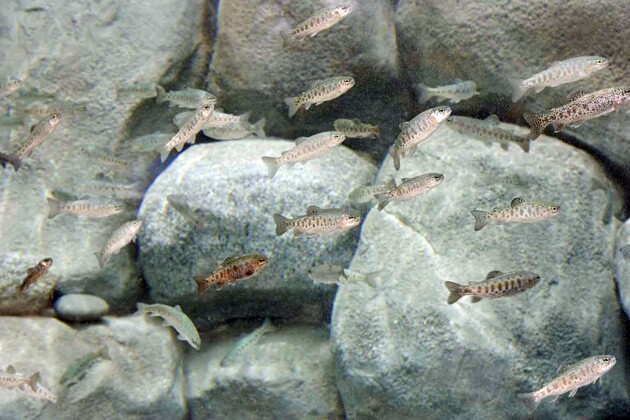New Exhibit Explores the Story of Steelhead Trout in Southern California

Before pobladores, ranch owners, and missionaries, there were steelhead trout, a cousin of salmon that have been part of the region's history as far back as 15,000 years ago. Chumash and Tongva Indians once hunted these trout species. Steelhead were abundant in Southern California until the 1930s, when Los Angeles paved its waterways and inadvertently hindered the steelhead's ability to return to the freshwater streams in order to breed. Where once large schools ran up and down the Los Angeles and San Gabriel Rivers, there are now thought to be only 500 adults left in Southern California.
"The story of the Southern California steelhead is the story of what we've done to our rivers and watershed," said Dr. Jerry Schubel, president and CEO of the Aquarium of the Pacific. Once the region's waterways were dammed up and concretized, the steelhead's upstream journey from ocean to stream suddenly became next to impossible. It's a testament to the species' drive that, despite its endangered status, some sightings have been reported at Malibu Creek and the mouth of the San Gabriel River.
A new exhibition (and accompanying book) at the Aquarium of the Pacific in Long Beach hopes to educate the public about the steelhead's plight and enlist them in its fight for survival. "The steelhead is an indicator species," said Anthony Spina, supervisor of the regulatory steelhead team at National Oceanic and Atmospheric Administration (NOAA). "Their presence shows the health of the watershed."
Just steps from a complementary interactive display about the local watershed, a wall of 20-foot long tanks recreate the steelhead's journey and its transformation along the way. "We wanted you to feel that you were walking along the San Gabriel River," said Schubel. Background sceneries on each of the tanks illustrate the type of environments each fish would have enjoyed at each stage of its life.


The species spawns on gravel nests in freshwater streams, where they grow as rainbow trout. Then, for reasons unknown, some rainbow trout become steelhead, losing their dotted complexion, taking on a silvery skin, and growing as long as 40 inches. Steelhead then make their way to the ocean and return to freshwater when it comes time to breed.
For now, the fish swimming in those tanks donated by the California Department of Fish and Wildlife(DFW) are not officially steelhead. They have yet to transform, but in time Schubel hopes some will one day change themselves into these iconic Southern California animal.
While these fish are cared for in captivity, Aquarium of the Pacific partners from the NOAA and DFW continue to implement the recovery plan that was finalized for the species in 2012. According to Spina, the two most crucial aspects of the plan involves restoring the steelhead's ability to access their breeding grounds and giving them enough water in which to swim upstream. Restoration efforts continue in Orange and Ventura Counties, funded by DFW's fisheries restoration grant program, according to Edmund Pert, DFW regional manager. Many of these projects involve working with private landowners to remove blockages to the steelhead's ascent.
With the exhibit, the agencies hope more people will learn about the species and involve themselves in watershed issues that affect both humans and wildlife. "The story doesn't necessarily have to be a sad ending," said Schubel, "We can help a happy ending for the steelhead and for the environment."


The Southern California Steelhead Story is part of the aquarium's Summer of Wonder suite of exhibits, which offer the public an opportunity to touch horseshoe crabs, see behind the scenes footage of shark feeding, and get to know the aquarium's breeding pair of endangered Guam Kingfishers.
Photos by Carren Jao


